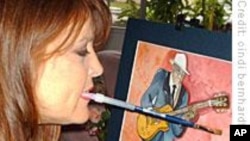<!-- IMAGE -->
The Mouth and Foot Painting Artists Association helps talented artists who paint for therapy and self expression advance their careers and market their work.
Cindi Bernhardt was 18 and starting college, when she had a life-changing accident.
"I was doing gymnastics in an area not designated for gymnastics and I lost control and broke through a second floor window and became quadriplegic, paralyzed from the shoulders down," she says. "So I can't use my arms or my legs and I'm in a wheelchair."
Bernhardt learned to hold a paintbrush in her mouth during occupational therapy
When she broke her neck more nearly 30 years ago, Bernhardt says, she never thought about becoming an artist.
"After being paralyzed, I was still and sitting and the occupational therapist asked me to learn to write with my mouth, because back in 1981, we didn't have the opportunity to be working with computers or voice dictation programs," she says. "After learning how to write just my name, I would doodle. I was kind of bored in the hospital, couldn't do much physically. One of the therapists saw that I had a gift and told me that I needed to pursue that," she says.
<!-- IMAGE -->
From student to successful professional artist
Cindi Bernhardt joined the Mouth and Foot Painting Artists, MFPA as a student, learning to paint water colors. She uses a soft plastic tube extender on her brush to extend her reach and protect her mouth. She moves her head to paint the longer strokes of a background, and uses her teeth to manipulate the brush for the details. The MFPA is producing and marketing her paintings on cards and calendars.
Bernhardt says that her success as an artist has taught her a lesson about never giving up.
<!-- IMAGE -->
"When you're first disabled of course, it seems hopeless and helpless. But there is always something that we can contribute to society," she says. "Whether you have a physical disability or an emotional, or whatever it might be, if you can't change it, you got to work with it," Bernhardt advises.
Bernhardt's mother attended art classes with her daughter. Jean Bernhardt says becoming a professional artist changed Cindi's life in a positive way.
"It has given her a purpose in life, for sure," she says. "She can express herself through the artwork. And people want to see her work and that encourages people to get in touch with her. So she's connected with other people, also. When I look at her work, I'm just amazed at it because being an artist, I look at it and think she did that with her mouth and I do it with my hand and I still can't sometimes achieve as much as she does with her mouth."
Quadriplegic painter Robert Thome mentors others
Robert Thome is also a mouth painter who became a quadriplegic in his teens following a sports injury.
"The only limitation that we have is our imagination," he says. "We put that down on canvas or paper and people can see some real courage and strength in all our images."
Since he joined the MFPA in 1984, he has participated in more than 200 art exhibitions.He mentors fellow MFPA artists and teaches at schools and community organizations. He also attends MFPA's conferences in the United States and around the world. Those gatherings, he says, provide an opportunity for disabled artists to support and learn from one another.
"We meet as an army of dedicated painters that want to show the world what we can do," he says. "Personally, when we meet each other, we mostly talk about our families, and [our] situations, because we all identify with our disabilities." Thome adds that MFPA gatherings provide an opportunity to exchange advice and information about programs and services available in different countries. He says, "The conferences are very inspiring. And when I leave, I get pumped up. I can hold my head high and feel that I have a place in this world."
MFPA founder was paralyzed by polio before WWII
Spreading a positive attitude among disabled artists was one reason the MFPA was founded more than 50 years ago, the group's spokesman James March says.
"A gentleman called Erich Stegmann had polio when he was about four years old, but he developed a reputation in Germany, pre-War [WWII] and post-War of being an exceptional artist, even though he painted with a brush held in his mouth," he says. "In 1956, he brought into his fold eight or nine more artists and they formed this association. Since then, there are now [more than] 700 artists in 70 countries all over the world. In North America, we've been here since 1961," March says.
He says there are now some 70 artists in the United States who paint using their mouth or foot. Through the association's web site, www.mfpausa.com, the public can see and purchase work and be inspired by the artists' talent, courage and abilities.




